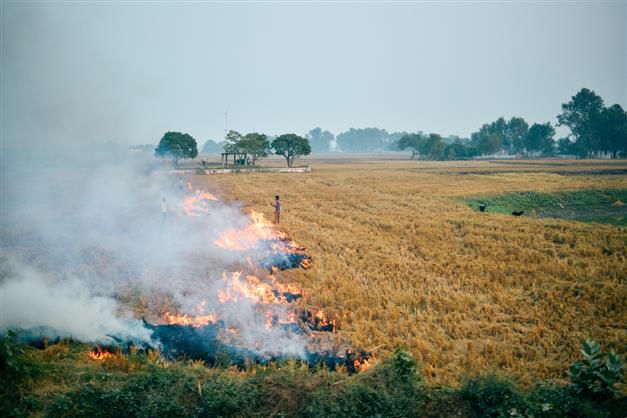Long-duration paddy variety use continues in Punjab despite environmental concerns: Report
New Delhi, July 2
Farmers in Punjab’s districts with the highest stubble-burning incidents continue to cultivate the long-duration and water-intensive paddy variety Pusa 44, according to a new survey released on Tuesday.
The survey, conducted by researchers from the Delhi-based independent think tank Council on Energy, Environment and Water (CEEW), also found that nearly half of Punjab farmers using in-situ crop residue management (CRM) machines still burn some loose paddy straw to ensure the machines’ efficient operation and for pest control.
The CEEW report highlighted that 36 per cent of the 1,478 farmers surveyed in 11 districts of Punjab grew Pusa 44 in Kharif 2022 due to its high yield.
The selected districts — Amritsar, Bathinda, Fatehgarh Sahib, Fazilka, Ferozepur, Gurdaspur, Jalandhar, Ludhiana, Patiala, Sangrur, and SBS Nagar — accounted for about 58 per cent of the Kharif fires reported in Punjab in 2022.
High- and medium-burn districts, such as Sangrur and Ludhiana, have the highest proportion of Pusa 44 growers.
Although farmers prefer Pusa 44 for its higher yield, current agricultural subsidies for electricity and fertiliser lead them to overlook the crop’s environmental impact, said Kurinji Kemanth, programme associate at CEEW.
Due to Pusa 44’s environmentally harmful characteristics, the state government de-notified the variety in October 2023. However, it remains in circulation primarily through private seed dealers, Kemanth added.
Historically, high-yielding long-duration varieties such as Pusa 44 and Peeli Pusa have dominated Punjab’s paddy fields. These varieties take longer to mature, generate excess straw, and require high agricultural inputs, including fertilisers and water.
Pusa 44, for instance, produces almost 2 tonnes of excess straw per hectare compared to its PR (Parmal Rice) variants, leading to more residue burning.
Since the early 2010s, the Punjab government has promoted nine short-duration varieties to combat groundwater depletion and stubble burning.
The acreage of these short-duration varieties has drastically increased in Punjab over the last decade from 32.6 per cent in 2012 to 69.8 per cent in 2021.
During the survey, over 66 per cent of the farmers reported cultivating short-duration PR varieties in 2022. Among these, PR 126 emerged as the most sought-after variety despite its limited supply.
The survey revealed that 57.7 per cent of PR growers sowed PR 126 in Kharif 2022. A significant reason for this demand surge was the Punjab government’s May 2022 announcement to procure summer moong dal at MSP if farmers sowed PR 126 or basmati after harvesting moong.
Farmers primarily opted for this newly promoted variety due to the assured procurement of summer moong by the government.
The findings showed the practice of stubble burning is more prevalent among medium and large farmers than small and marginal farmers, who fear receiving financial and red entries in the revenue records.
India’s food grain production has nearly tripled from 115.6 million tonnes (Mt) in 1960-61 to 329.6 Mt in 2022-23, driven by improved access to modern agricultural technologies stemming from the Green Revolution. However, this heightened production has led to unsustainable CRM strategies, such as stubble burning.
Of the 754 Mt of crop biomass produced annually, nearly 228 Mt remain as surplus after being utilised for purposes such as thatching and cattle bedding; the majority of it is burnt.
The practice of stubble burning is prevalent in northern states like Punjab and Haryana, where rice-wheat farming dominates.
Contributing factors include the paddy-wheat cropping system, cultivation of long-duration paddy varieties, mechanised harvesting that leaves standing crop stubble in the field, labour scarcity, and the lack of a viable market for crop residue.
Studies estimate that during peak burning periods, farm fires contribute up to 30 per cent of PM levels in the Delhi-NCR region and surrounding areas.









